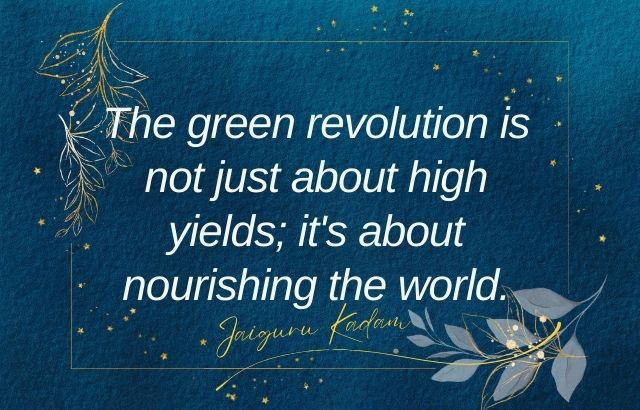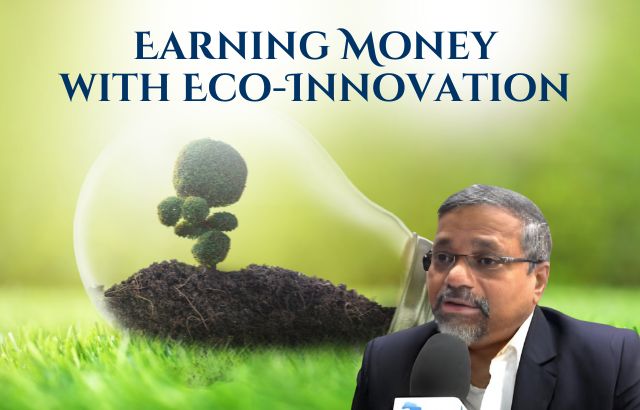In a world increasingly focused on sustainability, green innovators are not only pioneering environmental solutions but also finding ways to generate income while doing so. Let’s delve into the strategies and insights from these eco-conscious entrepreneurs who are leading the charge towards a greener, more profitable future.
Earning Money with Eco-Innovation

1. Solving Environmental Challenges Creatively
Green innovators approach environmental challenges as opportunities for creative problem-solving. By identifying pressing issues such as waste management, renewable energy, or sustainable agriculture, they develop innovative solutions that not only benefit the planet but also create economic value. Whether it’s designing biodegradable packaging, producing solar-powered devices, or implementing regenerative farming practices, these entrepreneurs prioritize sustainability while tapping into profitable markets.
Example: Company: EcoPack Solutions Innovation: Biodegradable Packaging Description: EcoPack Solutions develops biodegradable packaging solutions made from sustainable materials like plant-based plastics or compostable fibers. By addressing the pressing issue of plastic pollution, they provide eco-friendly alternatives for industries such as food and beverage, cosmetics, and consumer goods, while generating revenue through product sales and licensing agreements.
2. Leveraging Technology for Environmental Impact
Technology plays a pivotal role in driving eco-innovation forward. Green entrepreneurs harness the power of digital tools, data analytics, and emerging technologies to develop scalable solutions with far-reaching environmental impacts. From smart energy management systems to blockchain-based supply chain transparency, technology enables them to streamline processes, optimize resource utilization, and maximize efficiency, ultimately leading to cost savings and revenue generation.
Example: Company: EnergyWise Technologies Innovation: Smart Energy Management Systems Description: EnergyWise Technologies designs and implements smart energy management systems for commercial and industrial facilities. Their technology utilizes sensors, IoT devices, and machine learning algorithms to optimize energy usage, reduce waste, and lower operational costs. By helping businesses become more energy-efficient, they not only mitigate environmental impact but also generate revenue through system installation, maintenance, and energy savings.
3. Embracing Circular Economy Principles
In the circular economy, waste is minimized, and resources are kept in circulation for as long as possible. Green innovators adopt circular economy principles to design products and services that are regenerative by nature, thus reducing environmental impact while creating new revenue streams. By implementing strategies such as product lifecycle extension, remanufacturing, and resource recovery, they create value from waste and contribute to a more sustainable, profitable business model.
Example: Company: Re-Think Electronics Innovation: Remanufactured Electronics Description: Re-Think Electronics specializes in remanufacturing electronic devices such as smartphones, laptops, and tablets. They collect used electronics, refurbish them to like-new condition, and sell them at a lower cost than new devices. By extending the lifecycle of electronics and reducing e-waste, they create value from discarded products while earning revenue through device sales and aftermarket services.
4. Tapping into the Growing Demand for Sustainable Products and Services
Consumers are increasingly prioritizing sustainability in their purchasing decisions, creating a growing market for eco-friendly products and services. Green innovators capitalize on this trend by offering sustainable alternatives to conventional goods and services, ranging from organic food and ethically sourced fashion to eco-friendly home appliances and carbon-neutral transportation solutions. By aligning their offerings with consumer values and preferences, they tap into a lucrative market niche while driving positive environmental change.
Example: Company: GreenEats Innovation: Plant-Based Fast Food Description: GreenEats is a fast-food chain that offers a menu of plant-based burgers, salads, and wraps made from locally sourced, organic ingredients. Catering to the growing demand for healthy, sustainable food options, they attract eco-conscious consumers seeking environmentally friendly alternatives to traditional fast food. By tapping into this market niche, they generate revenue through restaurant sales, franchising, and catering services.
5. Collaborating for Collective Impact
Green innovators recognize that collaboration is essential for tackling complex environmental challenges effectively. They forge partnerships with like-minded organizations, government agencies, academic institutions, and community stakeholders to pool resources, share expertise, and scale impact. Through collaborative initiatives such as innovation hubs, accelerators, and cross-sectoral alliances, they leverage collective strength to drive systemic change and create new opportunities for sustainable economic growth.
Example: Initiative: Sustainable City Project Collaborators: City Government, NGOs, Private Sector Description: The Sustainable City Project is a collaborative initiative aimed at transforming a city into a model of sustainability. Partners include the city government, local NGOs, and private sector companies specializing in urban planning, renewable energy, waste management, and green building. By pooling resources, sharing expertise, and coordinating efforts, they work towards common goals such as reducing carbon emissions, improving air and water quality, and enhancing quality of life for residents. Funding for the project comes from government grants, corporate sponsorships, and community donations.
These examples demonstrate how green innovators are not only addressing environmental challenges but also creating value and generating revenue through innovative, sustainable business practices.
How can businesses earn money with eco-innovation?
Answer: Businesses can earn money with eco-innovation by developing sustainable products, improving energy efficiency, reducing waste, and leveraging renewable energy sources. These practices not only reduce costs but also meet the growing consumer demand for environmentally-friendly options.
What are the benefits of eco-innovation for businesses?
Answer: Eco-innovation benefits businesses by enhancing their reputation, increasing customer loyalty, reducing operational costs, and opening new market opportunities. Additionally, it helps in complying with environmental regulations and attracting investment.
What types of businesses can benefit from eco-innovation?
Answer: All types of businesses can benefit from eco-innovation, including manufacturing, agriculture, technology, retail, and service industries. By adopting sustainable practices, these businesses can improve efficiency, reduce costs, and appeal to eco-conscious consumers.
How does the circular economy contribute to earning money with eco-innovation?
Answer: The circular economy contributes by promoting the reuse, recycling, and repurposing of materials, reducing waste, and creating new revenue streams. Businesses can save money on raw materials and gain competitive advantages by offering sustainable products.
What role does technology play in eco-innovation?
Answer: Technology plays a crucial role in eco-innovation by enabling the development of energy-efficient products, optimizing resource usage, and facilitating the creation of renewable energy solutions. Innovations such as smart grids, IoT, and AI help businesses become more sustainable and profitable.
How can collaboration enhance eco-innovation efforts?
Answer: Collaboration enhances eco-innovation by bringing together diverse expertise and resources, fostering creative solutions to environmental challenges, and amplifying impact. Partnerships between businesses, governments, and NGOs can drive large-scale sustainable initiatives and open new opportunities for growth.
What are some examples of successful eco-innovative businesses?
Answer: Successful examples include companies in renewable energy, sustainable agriculture, green building materials, and eco-friendly consumer goods. These businesses have implemented innovative solutions to reduce their environmental footprint while achieving financial success.
How can small businesses start with eco-innovation?
Answer: Small businesses can start with eco-innovation by assessing their environmental impact, setting sustainability goals, and implementing simple measures like reducing energy consumption, minimizing waste, and sourcing eco-friendly materials. Gradually, they can invest in more advanced sustainable technologies and practices.
Conclusion

In conclusion, earning money with eco-innovation is not only possible but also essential for building a sustainable future. By solving environmental challenges creatively, leveraging technology, embracing circular economy principles, tapping into the growing demand for sustainable products and services, and collaborating for collective impact, green innovators are paving the way for a greener, more prosperous world. As we continue to navigate the challenges of the 21st century, let us draw inspiration from these visionary entrepreneurs and work together towards a sustainable economy that benefits both people and the planet.
About Author

Jaiguru Kadam stands as a beacon of innovation and sustainability in the realm of agriculture and chemical processes. Recognized as “The Green Innovator,” Kadam’s relentless pursuit of eco-friendly solutions has reshaped traditional practices, paving the way for a greener and more sustainable future.
At the forefront of Kadam’s contributions is the introduction of Green Solvents, a groundbreaking concept that minimizes the environmental footprint of chemical processes. By replacing conventional solvents with eco-friendly alternatives, Kadam has significantly reduced the adverse impact of chemical production on ecosystems.
Moreover, Kadam’s ingenuity extends to the realm of pesticide effectiveness with the development of Green Surfactants/Adjuvants. These novel additives not only enhance the efficacy of pesticides but also mitigate the potential harm they may cause to the environment, striking a delicate balance between agricultural productivity and ecological preservation.
In advocating for Plant-Derived Herbicides/Bioherbicides, Kadam champions sustainable weed management practices. By harnessing the power of nature’s own defenses, these bio-based solutions offer effective weed control while minimizing reliance on synthetic chemicals, thus promoting a more harmonious relationship between agriculture and the environment.
Perhaps most impressive is Kadam’s innovation in the realm of Green Herbicide Safeners. These pioneering technologies ensure the protection of crops while simultaneously controlling weeds, offering farmers a holistic solution that prioritizes both yield and environmental stewardship.
Through his visionary leadership and unwavering commitment to sustainability, Jaiguru Kadam has not only revolutionized agricultural practices but has also inspired a generation of researchers and practitioners to prioritize environmental responsibility in their pursuits. As the world grapples with the challenges of climate change and ecological degradation, Kadam’s pioneering work serves as a guiding light, illuminating a path towards a greener and more sustainable future for generations to come.












